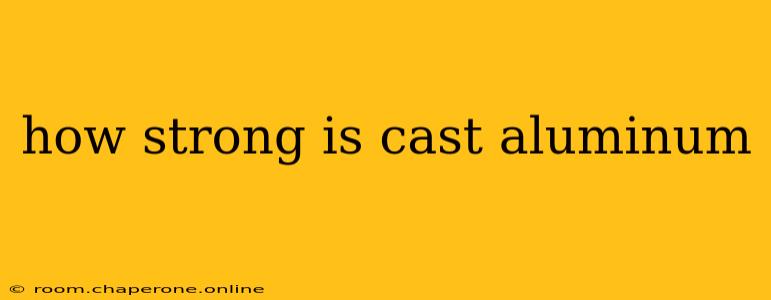Cast aluminum, a versatile and widely used metal alloy, offers a compelling blend of properties that make it suitable for a diverse range of applications. But just how strong is it? The answer isn't a simple number, as its strength depends heavily on several factors. This comprehensive guide delves into the intricacies of cast aluminum's strength, examining its advantages, limitations, and practical implications.
Understanding the Strength of Cast Aluminum
The strength of cast aluminum isn't measured by a single metric. Instead, several properties contribute to its overall structural performance:
-
Tensile Strength: This measures the maximum stress a material can withstand before breaking under tension. Cast aluminum's tensile strength varies considerably depending on the alloying elements and the casting process, typically ranging from 16,000 to 40,000 psi (pounds per square inch). Higher tensile strength indicates greater resistance to stretching and pulling forces.
-
Yield Strength: This represents the stress at which a material begins to deform permanently. It's crucial for ensuring that a component maintains its shape under load. Similar to tensile strength, the yield strength of cast aluminum varies significantly based on the alloy and processing.
-
Compressive Strength: This measures the material's resistance to crushing forces. Cast aluminum generally exhibits good compressive strength, making it suitable for applications where it experiences compression loads.
-
Shear Strength: This indicates the material's resistance to forces that cause it to slide or shear. Cast aluminum's shear strength is also dependent on the alloy and casting method.
-
Fatigue Strength: This refers to the material's ability to withstand repeated cyclical loading without fracturing. Cast aluminum's fatigue strength is affected by factors like surface finish, internal stresses, and the presence of defects.
Factors Affecting Cast Aluminum Strength
Several factors influence the final strength characteristics of cast aluminum components:
-
Alloy Composition: Different alloying elements (such as silicon, magnesium, copper) significantly impact the mechanical properties of the aluminum. Specific alloys are engineered for higher strength, while others prioritize other properties like castability or corrosion resistance.
-
Casting Process: The method used to cast the aluminum (sand casting, die casting, investment casting, etc.) affects the microstructure and, consequently, the strength. Die casting, for example, generally produces parts with higher strength than sand casting due to finer grain structures.
-
Heat Treatment: Specific heat treatments can significantly enhance the strength of certain cast aluminum alloys by altering the microstructure. This process can involve solutionizing and aging to increase both tensile and yield strength.
-
Part Design: The geometry and design of the cast component play a critical role in its overall strength. Stress concentrations in sharp corners or thin sections can significantly weaken the part.
Applications of Cast Aluminum Based on Strength
The diverse strength characteristics of cast aluminum make it suitable for a wide range of applications, including:
-
Automotive Components: Engine blocks, cylinder heads, transmission cases, and other parts benefit from cast aluminum's combination of strength, lightweight nature, and good castability.
-
Aerospace Components: Its lightweight yet relatively strong properties make it attractive for aircraft components, though often used in conjunction with other high-strength materials.
-
Machinery Parts: Cast aluminum finds use in various machinery components where strength and dimensional stability are important.
-
Building and Construction: Structural elements, façade components, and decorative features can utilize the strength and aesthetic appeal of cast aluminum.
Limitations of Cast Aluminum
While strong, cast aluminum does have limitations:
-
Lower Strength Compared to Wrought Aluminum: Cast aluminum generally has lower strength compared to wrought aluminum (aluminum that's been formed by processes like rolling or extrusion).
-
Sensitivity to Defects: Casting processes can sometimes introduce porosity or other defects that can weaken the material.
-
Creep: At elevated temperatures, cast aluminum can exhibit creep (slow deformation under sustained stress).
Conclusion: Choosing the Right Cast Aluminum Alloy
The strength of cast aluminum is highly dependent on the alloy used, the casting process, and the part design. Understanding these factors is crucial for engineers to select the appropriate aluminum alloy for their specific application, ensuring the component meets the necessary strength requirements while optimizing other properties like weight and cost. Consult relevant material specifications and engineering handbooks for detailed information on specific alloys and their mechanical properties.

